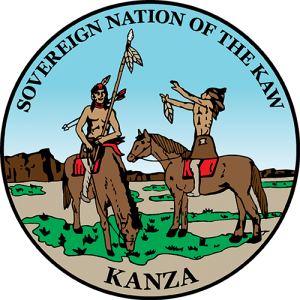History of the Government of the Kaw Nation Since 1902
The Kaw Allotment Act was passed on July, 1, 1902. The Act provided approximately 400 acres of land under government trusteeship to 249 persons whose names were placed on the final allotment rolls. What was left of the tribe went through a period of weak leadership. In the 1920s, Lucy Tayiah-Eads was elected Chief and attempted to gain recognition from the Federal Government. However, these requests were said to be contrary to the Allotment Agreement and denied. In 1951, a settlement was released to the tribe, and money was set aside to protect the cemetery. This led to the creation of a six-member Kaw Cemetery Association. In 1955, the General Services Administration of the United States Government sold the land where the Kaw Agency stood. The 96/100 acre plot where the old council house stood was repainted for the tribe. These actions led to the formation of the Kaw Business Committee.
In 1958, under the direction of the Pawnee Indian Agent and Anadarko Area Director, notices of a meeting to draft a set of by-laws and a Constitution were sent to the Kaw people. This meeting took place on October 8th, and had approximately 150 people in attendance. This was adopted by a majority vote at the meeting and approved by the Secretary of the Interior on July 23, 1959. From this time until the mid 1970s, the Nation went through a period of internal disagreement. The 1958 Resolution was approved by the General Council on November 16, 1975. The 1958 resolution was the governing document of the tribe until 1990.
In 1990, the tribe adopted the first Kaw constitution. At the March 2000 General Council meeting, the need to amend the Kaw Constitution was addressed and the Constitution Committee was established. Over the next year the committee held meetings, sent out a survey, and provided a list of recommended changes to the Executive Council. The Executive Council considered the changes and voted against sending them to the Kaw People for ratification. Shortly thereafter, the committee was basically disbanded. The Committee was revitalized in January 2005. The Executive Council approved and sent to the General Council for ratification the only amendment (to the 1990 Constitution) which was adopted in 2004. It was agreed to by a vote of the Kaw People in 2006. This amendment removed the Secretary of the Interior’s approval of any future amendments to the Constitution. The Constitution Committee held a training session with Falmouth Institute in April of 2008. At this training, amendments were discussed and it was decided that additional work was going to be needed to complete a revision of the Constitution. The Kaw Nation then applied for and was awarded a grant from the Administration for Native Americans (ANA) in 2008 for the purpose of revising their constitution. This was a three-year grant and the purpose was to revise the Constitution and to draft various policies and procedures of the Kaw Nation.
Starting in the spring of 2009 the Constitution Committee set out the task of revising the Constitution. Over the next two years, the Committee held nearly a dozen public meetings for Tribal Citizens to solicit comments, sent out two surveys, and drafted a new Constitution. A signed petition was presented to the Chairman at the April 2011 General Council meeting. This petition was certified by the Kaw Nation District Court and a vote was set for August 20, 2011 for the Kaw People to vote for or against ratification. The Kaw people voted 58 percent to 42 percent to accept the new Constitution as the organic law of the land. Shortly thereafter, the Kaw Nation Tribal Council (formerly known as the Executive Council) began diligently working to implement the new Constitution. The 2011 Constitution calls for several actions to be voted on by the General Council and these are currently being prepared for future General Council meetings.
References: The Kaw People by William Unrau and General Council minutes of the Kaw Nation and compiled by Aaron Carlson, Project Coordinator.
